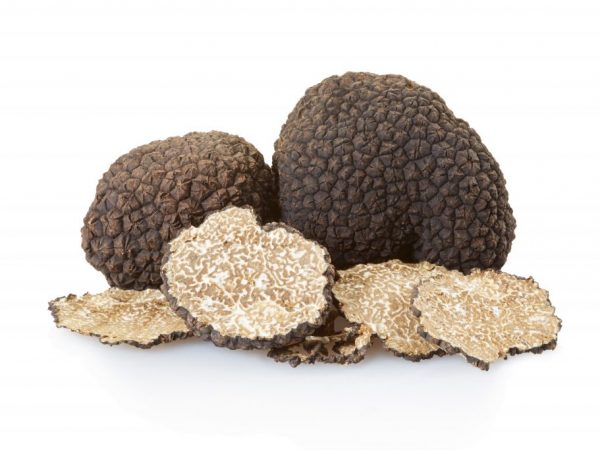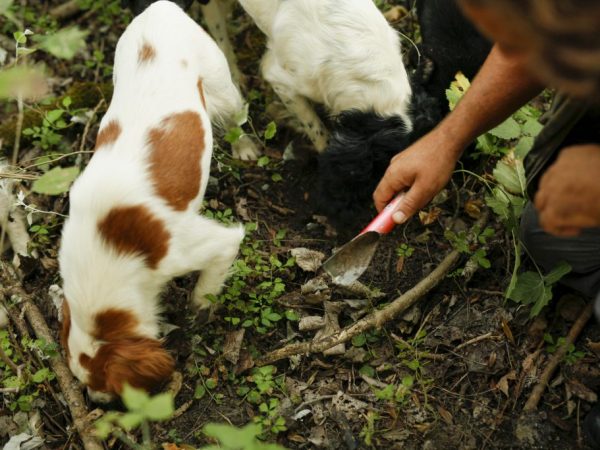Where to find truffles in Russia
An uncommon expensive truffle is difficult to find. You need to look for it under a layer of earth near the roots of trees, while the fungus is not found on all continents. There are several places where truffles grow in Russia.

Where to find truffles in Russia
Where to find truffle
A rare species, it prefers countries with a warm climate. The Russian truffle sites map includes a number of main areas, such as:
- Moscow;
- Vladimirskaya;
- Kostroma;
- Tula;
- Middle Volga region;
- Smolenskaya;
- Orlovskaya.
The main places where truffles are distributed in nature are Portugal, Germany, France, Italy and Spain.
The place of growth of these valuable fungi is the upper layers of the soil. Under the earthen layer, they form a mycorrhiza with the root system of certain types of trees. They prefer to grow on loose soils rich in limestone and iron.
Varieties and their range
The appearance of the mushroom is unattractive, similar to the tubers of Jerusalem artichoke or potatoes. Truffle, according to the species description, is smooth, excised with grooves, or covered with warts and tubercles. The skin is brown, the inside is soft.
The size is often the size of a small nut or grape berry. Only a few varieties grow to the size of a large apple, while reaching 15 cm in diameter. Weight - 100-500 g.
Among the varieties of truffles, one of the most valuable in terms of gastronomic qualities is black, or Perigord. One of the most expensive is the rare Piedmontese.
Truffle grows mainly in families or nests - truffles. Different species have their own color and place of growth.
In Russia, truffles are represented by two main types:
- Black summer (also called Russian): occurs on the Russian Black Sea coast near the Caucasus region, in the suburban areas of Sochi and in Crimea. It grows mainly in forests of deciduous and mixed types, meeting among conifers extremely rarely, growing in symbiosis with the roots of pine and hazel.
- White truffle: grows in some central regions of Russia, including Moscow and Leningrad, preferring to settle near oak roots and near some deciduous trees.
Irina Selyutina (Biologist):
The black summer and white truffles found on the territory of Russia are characterized by a number of peculiarities. If you know exactly the external characteristics and places of growth, you can harvest these delicious mushrooms.
Features of these types of truffles:
- The taste of the black Russian truffle is characterized by the presence of nutty notes and a sweetish aftertaste perfectly combined with a strong pleasant smell, which is compared to the smell of algae or forest litter.
- For a white truffle (the color of the surface of the fruit body is still not white, but yellow-brown), the mushroom pulp has the taste of a walnut or roasted seeds.
- The old fruiting bodies of the black summer truffle sometimes come to the surface.
- For white truffles, the soil rises above the fruiting bodies, and it is very rare that they appear on the surface.
- White truffles bear fruit every few years.
By the way. In the Kostroma region, white truffles are called "cow's bread": when animals graze in forest glades, they find these mushrooms by smell, dig them up and eat them. This addiction of cows and sheep to truffles allows mushroom pickers to find the locations of the truffles.
Some specimens of the black winter truffle were found in the mountainous areas of the Crimea, the red truffle is found in the Siberian forests.
When to collect and how to search

Mushrooms help find specially trained dogs
Each species has its own fruiting season:
- black summer (Russian) truffle: it is easier to detect than other species, since its fruiting bodies are located close to the surface, its harvesting season begins in summer and lasts until the beginning of autumn,
- black winter truffle: rare in Russia, the species actively bears fruit in January-March,
- white truffle: The variety, less valuable in its gastronomic qualities, ripens starting in the second half of autumn, the fruiting period lasts until the onset of winter.
How to find
All varieties of truffles grow at a depth of 15-20 cm from the surface of the earth. For the formation of symbiosis, mushrooms often choose oaks, beech, hornbeam, birch or hazel, but it is permissible to look for them among the roots of conifers, including under pines and firs; they are found among junipers.
If a fungus is found, it is carefully dug out of the soil layer without damaging the mycelium and tree roots.
The search for mushroom places is carried out using special equipment and with the help of animals trained for this: dogs and pigs, capable of detecting mushrooms by smell. The odor exuded by the mushrooms becomes more intense at night.
It happens that truffles appear above ground level, however, such specimens are usually overgrown, have lost all edible, healthy and taste qualities and are no longer suitable for culinary purposes.
There are additional signs that can show the presence of mycelium: withered vegetation in the place of growth and an ash-gray color of the soil layer. Above the place where the truffles are hidden, a large number of midges are often noticeable.
Conclusion
In Russia, the places where truffles are found are limited to several areas. The species that can actually be found on the domestic territory are black summer and white. Truffle mycelium is searched for with the use of special equipment according to the characteristic signs of presence and a specific smell, for which they resort to the help of trained dogs and pigs. Harvested at different periods of fruiting, which each variety has its own.



